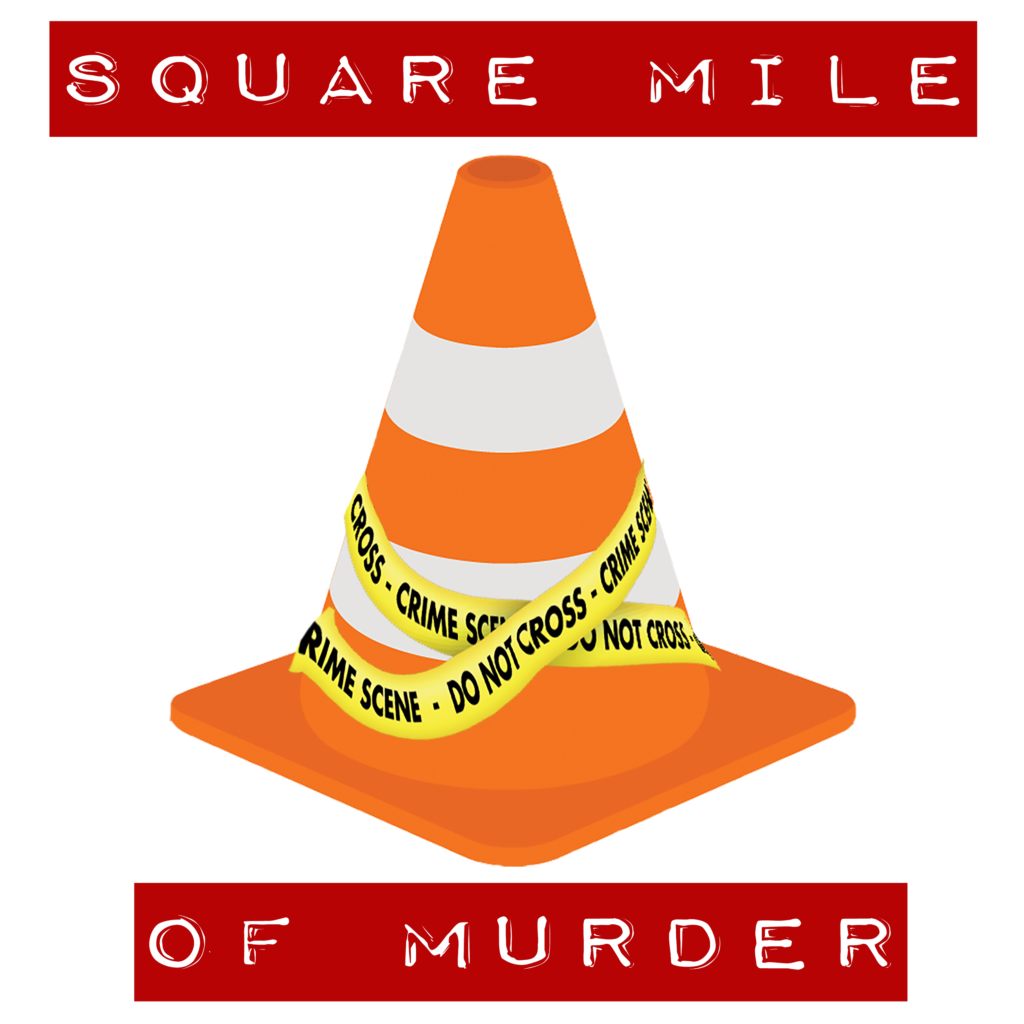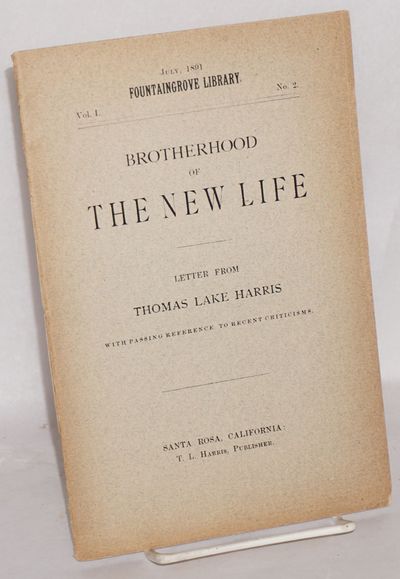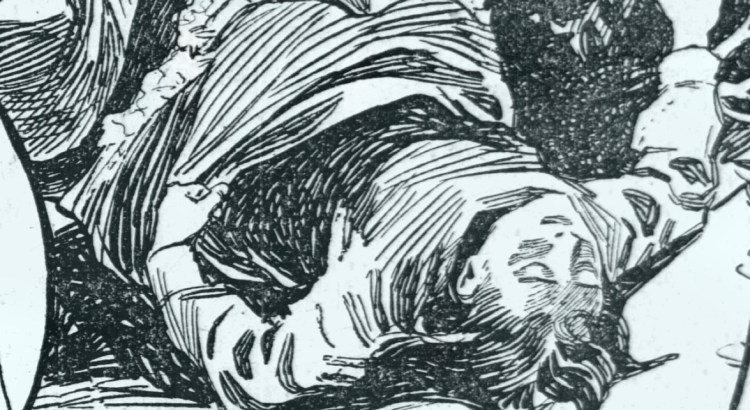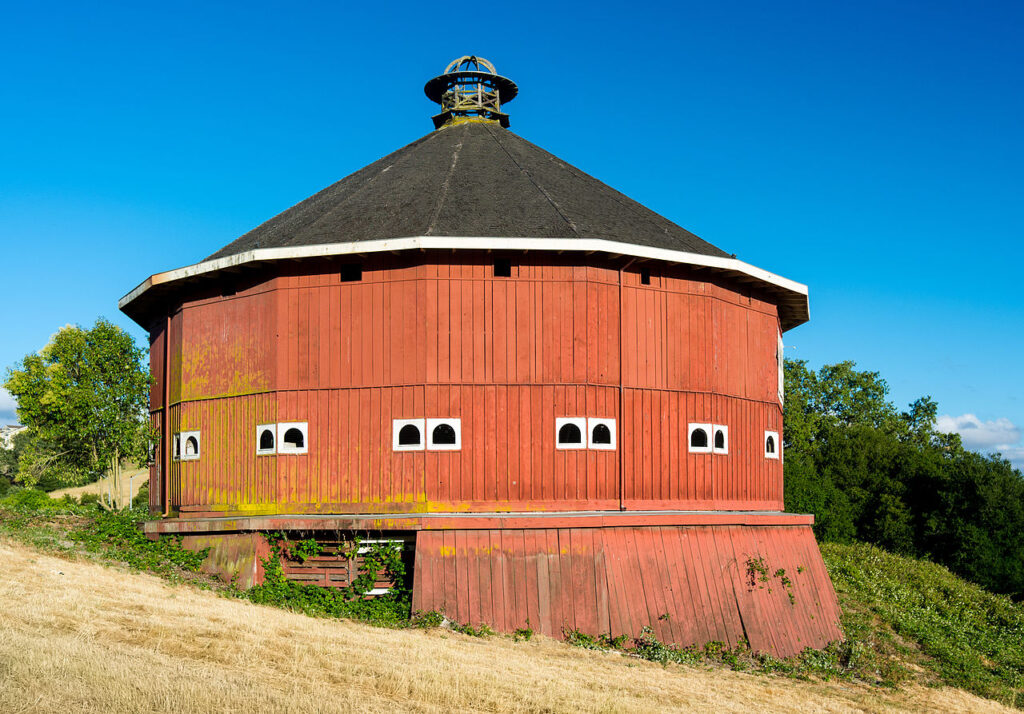Glasgow is a city known for many things. It’s a university town. There’s a famous football rivalry. There’s a long history of shipbuilding and industry. The city is home of breweries and distilleries. And it’s home to a wide range of people from different countries, cultures, religions, and ethnicities. But did you know that at the turn of the 20th century, there existed a Glasgow sex cult and was host to a most peculiar man: Thomas Lake Harris. Harris was the leader of a religious sex cult based in California. And he had friends in Glasgow whose home he fled to after things got hot at his Santa Rosa commune. Today we’re going to tell you all about Thomas Lake Harris, the sex cult he founded: the Brotherhood of the New Life, and his fateful visit to Glasgow.
THOMAS LAKE HARRIS
Thomas Lake Harris was born on May 15, 1823 in Fenny Stratford (now part of Milton Keynes) in Buckinghamshire, England. His parents were strict Calvinistic Baptists and had little money. And here is where we start to see the first of many similarities this story shares with the story of the Oneida Community and John Humphrey Noyes. Though Noyes was about 10 years older than Harris, their paths took surprisingly similar routes in some similar locales. If you haven’t listened to our episode about Noyes and the Oneida Community, we recommend you do that first and then come back to this episode because we got into more of the nitty gritty of Calvinism in that one. Harris felt smothered by his parents’ religion growing up and even went so far to later say that it “poisoned his spirit.”
When Harris was just five years old his family moved from England to Utica in upstate New York, which just so happens to be the county seat of Oneida County in New York. Go figure. Harris’s mother died at some point during his childhood which forced him to help support the family starting at age 9. During this time he also educated himself, though how exactly is unclear, not many sources cover his early life. By age seventeen he had accepted God as “the loving parent of the wide-spread family of man” after having a vision of his dead mother where their spirits communicated. By the age of 21 he became a Universalist minister of the Fourth Universalist Church in New York City’s Upper West Side. And in another four years he became a minister at the Independent Christian Congregation of New York.
Let’s talk for a second about Universalism. Universalism is actually not just a Christian thing. At its core, Universalism is the philosophical and theological concept that some ideas have universal application or applicability. And universalism also focuses on a belief in one fundamental truth which transcends the national, cultural, or religious boundaries or interpretations of that truth.
This concept has influenced a long list of religions including Buddhism, Christianity, Hindiuism, Islam, Judaism, Sikhism, and Unitarian Universalism. In this case, Harris was involved with Christian universalism which is based on the fundamental idea of universal reconciliation and that all humans will eventually be saved and enter the kingdom of Heaven. They also believe that an eternal hell does not exist and this concept goes against Jesus’s teachings.
So this is the kind of preaching and ministering Harris was doing at the Independent Christian Congregation of New York. And a member of this congregation was none other than Horace Greeley who was a New York newspaper editor and publisher. He had founded the New-York Tribune in 1841 and quickly became moved by Harris’s sermons. One such sermon about the suffering of children on the streets of the city so moved Greeley that he asked members of the congregation to stay behind after the sermon was over and they worked together to plan out the founding of the New York Juvenile Asylum. This asylum (now called The Children’s Village) cared for, trained, and “morally uplifted” the City’s poor children.
So his sermons were so moving that they could help found social institutions! Harris soon became a popular speaker, writer, and poet. During this period his interests turned towards spiritualism (a movement based on the belief that the spirits of the dead exist and have the ability and inclination to communicate with the living) and Swedenborgianism.
Swedenborgianism stems from the teachings of Swedish mystic Emanuel Swedenborg who was a pluralistic-Christian theologian, scientist, philosopher, and inventor in the 1700s. Swedenborg had a “spiritual awakening” in which the lord had opened his spiritual eyes allowing him to freely visit heaven and hell which, of course, allowed him to have conversations with angels, demons, and other spirits. Oh and also the last judgement occurred in 1757, the year before he published his work describing this whole experience. Followers of Swedenborgianism (also called The New Church) believed that anyone who was spiritually advanced and aware enough could communicate with angels in heaven.
Harris was super into this concept and quickly started incorporating Swedenborg’s ideas into his own teachings and writings. And, not satisfied with preaching in New York, Harris left in 1851 for Virginia. In Virginia he co-founded the Mountain Cove Community of Spiritualists with Reverend J. L. Scott. The two men claimed that the land on which they settled their community was the actual site of the Garden of Eden and not just some random plot of land in the mid-atlantic USA. The Mountain Cove Community was built to be a refuge where angels could ascend and descend and basically come hang out for a while. However, Mountain Cove didn’t last long. According to an account by William Alfred Hinds: “The serpent again made trouble in the Garden of Eden; there were quarrels about property, and rebellion against leaders; and in two years the city of refuge became a city of discord and confusion; and those who had fled to the mountain now fled to their former homes.”
Following the complete disaster of Mountain Cove, Harris moved to England and spent several years preaching his theology to a congregation in London. He also published many books while in London. But he soon grew restless in London and made his way back to the US, settling in the town of Amenia in Dutchess County, New York.
BROTHERHOOD OF THE NEW LIFE
In Amenia he spent five years preaching and building up the infrastructure of the town (not unlike John Humphrey Noyes in Putney and Oneida). In that time he helped establish a bank, a flour mill, and a large vineyard/winery. He also amassed a group of about 60 followers including five orthodox clergymen and around 20 Japanese people originally from the Satsuma Province. So what’s a preacher to do with a big ole group of devotees and some cash from commercial and industrial enterprise? Start a community of course!
And that’s just what Harris did. 14 years after the utter failure of the Mountain Cove Community, Harris founded the Brotherhood of the New Life which settled in the village of Brocton, New York on the shore of Lake Erie. The Brotherhood was run as a co-operative rather than a commune. The main difference being that co-operatives are founded as a group voluntarily sharing resources towards a common goal versus communes that force members to distribute all wealth and resources equally.
The Brotherhood of the New Life grew quickly and ran various farming and industrial businesses. While all this co-operative business was going on, Harris was also preaching some interesting things to his followers including that God and Jesus were both male and female and that sex was the true power behind human existence. He believed that Christianity had made the wrong choice to focus on sexual repression and he preached that sexual energy, with some help from angels, would rid the world of mortal evil. Also men and women were originally androgynous before humans evlolved and as such each person was constantly looking for their spiritual “other half” who only existed in another realm.
And perhaps the best of Harris’s teachings was the idea that if one changed the way they breathed they could reach a higher state of divine consciousness and allow angelic beings to flow through their body. They called this practice “open breathing” and it was similar in nature to yogic breathing. The community also had a successful winery which was initially attacked by teetotallers and supporters of temperance. But Harris assured them that his wine was so full of this angelic breath that all the bad effects of alcohol were breathed away and actually his wine was angelic and divine.
He was also obsessed with fairies and would often “let the fairies speak through him” and claimed to have a fairy wife named Queen Lily.
But Harris’s teachings weren’t all funny breathing, fairies, and sex. Like many cult leaders, Harris demanded total devotion from his followers. This included handing over all worldly possessions and wealth to Harris upon joining the community. And some wannabe members were even rejected because they deemed not wealthy enough to join the community. So he was only looking for the big bucks.
He also had his followers practice a number of different demeaning rituals. One famous follower of Harris was Laurance Oliphant, a famous British author, diplomat, and Member of Parliament. Oliphant and his mother, Lady Oliphant, became enamoured with Harris during his time in England and quickly became devout followers. Laurance Oliphant was initially denied entry to the Brotherhood of the New Life because he wasn’t wealthy enough. But after getting his wealthy mother to join, Harris let Oliphant in. But Harris insisted that Oliphant, who was at that time serving a term in Parliament, take a vow of unwavering silence. Oliphant did this for two years. In 1867 Oliphant disappeared from London and wasn’t seen again until 1870. He was found in the US working as a labourer at the Brotherhood of the New Life. He laboured and lived in silence for an extended period of time and kept away from his mother. And it was Lady Oliphant’s fortune which allowed Harris to purchase the property in Brocton where the Brotherhood settled.
Oliphant was allowed back into the wider world but had to be ready to return to Harris at a moment’s notice. Oliphant served as a journalist during the Franco-Prussian war and met his future wife, Alice, in 1872. Oliphant had to get Harris’s approval to wed Alice which was only given after Alice agreed to sign over her entire fortune and property to Harris. The couple married but were quickly separated by Harris. He forced Alice to leave the community to earn a living (while keeping control of all her assets) while he sent Oliphant out to New York to work as a director of a cable company. He kept the couple apart for years.
This is the major account of what life was like inside the Brotherhood of the New Life community, so you can imagine that life was probably much worse for the members who didn’t have wealthy families or globally recognised fame.
FOUNTAINGROVE
Despite these conditions, the Brotherhood of the New Life was quite popular and it’s followers reached around 2,000 both in the United States and in the UK. Following this success, Harris decided to move a chunk of the group out to Santa Rosa, California. He claimed that he had received a message from God to move there, but more likely he realised that the climate in Santa Rosa was just a heck of a lot better for winemaking than upstate New York. In Santa Rosa in 1875, Harris founded the Fountain Grove community.
GLASGOW
So you’ve come this far and you’re probably thinking: okay guys you said this was about Glasgow and so far you haven’t mentioned that all. We’re getting there, we promise! One of Harris’s devoted followers was Insurance broker Charles Pearce. Pearce initially became interested in Spiritualism in the 1860s and became a medium, hosting seances and delivering lectures about how the occult and christianity could work together. He soon became interested in Harris’s ideas and even visited the various locations of the Brotherhood over the years. In 1872 he was rejected as a member of the New York settlement because he wasn’t rich enough. However he and Harris remained in correspondence. In their letters Harris called Pearce “Sir Steadfast Hold Strong” due to his unwavering loyalty and Pearce called Harris “Father”.
Once the Brotherhood moved to Santa Rosa, Pearce decided to import and sell their wine “made by consecrated hands” through his own company, CW Pearce & Co. Because of this decision, Fountaingrove wine was actually the first California wine to be imported and commercially sold in Britain.
Pearce was an outspoken socialist and defender of women’s rights. He wrote often in Labour publications about how men and women were, though physically and mentally different, essentially equal and should be treated as such. He also wrote of the terrible “brutal lust of the dominant male” and argued for bodily autonomy for women as well as equal access to divorce. These views soon attracted his future wife, Bella, an outspoken and fiery feminist activist. The two married in 1891 and continued devoting their lives to both Harris’s teachings and labour, socialist, and feminist causes. With the Pearces’ help, Harris began to build a small group of supporters in Glasgow. But scandals back in America made it difficult for Harris to gain widespread support.
SCANDALS
And what of those scandals you may ask. Well a big one had to do with Laurance Oliphant. After being separated from his wife for years, the two were finally allowed to reunite. But Oliphant’s beloved mother soon became ill and died. After her death, Harris’s hold over Oliphant shattered and Oliphant broke with the Brotherhood and with Harris. He charged Harris with fraud and robbery and actually managed to recover a great deal of his fortune through legal action against Harris. Sources differ on this, but some say that Oliphant left the Brotherhood but his wife stayed behind. And though Oliphant disagreed with Harris as a person, he still believed in his teachings and would continue to champion them throughout his life. His cousin, British writer Margaret Oliphant, published a memoir of Laurance Oliphant in 1891 detailing the whole affair which quickly caused scandal and trouble for Harris.
After moving out to Fountaingrove, Harris had become more secluded and shied away from public life. He instead remained in private and issued writings to a secret circle of his followers that largely dealt with sex.
By 1891 he declared that his body had been renewed to a “youthful vigor” and that he had discovered the secret of resuscitation and was now immortal.
And in 1891 even more trouble came for Harris in the form of “suffragist, sociologist, spiritual scientist, nationalist, magazine writer, and reformer, Alzire Chevallier. Alzire and her mother spent six months at Fountaingrove before leaving in a “disillusioned huff”. She vowed to expose Harris and even threatened to present evidence of immorality and fraud to the President of the United States. She gave lectures where she demanded Harris be sent to prison and charged him with being a vampire, a lecherous fiend, a horrible sensualist, and the greatest black magician of the day. San Francisco papers ran with Chevallier’s characterisations of Harris and he was swarmed with disgrace. Harris fled California, but not before marrying one of his longtime followers, Jane Lee Waring, an heiress. The pair fled to Manhattan where Harris largely retired from public life and the management of his communities.
Glasgow’s press was just as suspicious of Harris as San Francisco’s and many publications ran stories denouncing him. The Glasgow Evening News published a report that he had “poached” a few promising young men from Glasgow to join his “weird, impossible colony of communistic cranks.” Another publication, The Wave, called Fountaingrove an “idealised house of sin” and “a den of iniquitous debauchees whose only religion is the satisfaction of the passions.”
An handful of reports surfaced that Harris had declared that community members’ celestial partners would inhabit his body and only through sex with him could they commune with their true soul mates. And another huge blow to the community came with the death of Harris’s own granddaughter, 15-year-old Mary M. Harris at fountaingrove in 1896. Fountaingrove’s higher-ups took great pains to get Mary’s death publiscised as a suicide though there is now much debate over the accuracy of those claims. Mary died after taking an overdose of strychnine. The official story involved Mary taking the poison in a fit of “temporary insanity” in an effort to scare other members of the community. This is how Kanaye Nagasawa put it. Nagasawa was Harris’s protege and had taken over the running of Fountaingrove after Harris fled. There is some speculation that Mary may have actually taken her own life because she was being forced into an arranged marriage.
It was after these events that Harris and Waring came to Glasgow in 1903. They stayed with Charles and Bella Pearce in their Langside villa South of the river Clyde. Their home had become the unofficial hub of Harris’s teachings in Britain and during his visit the house received a steady stream of curious visitors. However most of these visitors were just that, curious, but not serious, much to Harris and Waring’s dismay. By this point he was 80 years old, and perhaps his captivating influence was waning. The Glasgow Spiritualist Society cancelled a talk he had planned with them and a feature about him that was supposed to appear in the Glasgow Evening News was never printed.
But the Pearces delighted in Harris’s company and were mesmerised by him. He would allow the fairies to speak through him each morning at breakfast and spoke often of his spiritual fairy wife, Queen Lily, and claimed she lived with their spiritual children in Lillistan in the Kingdom of Heaven. His efforts in Glasgow did earn him one devoted follower: 62-year-old Jessie Donaldson. Donaldson was, according to Glasgow Live, a six-foot-three pianist and a “rich soul”. Donaldson returned with Harris to New York.
This visit to Glasgow was ultimately the last gasp for Harris, who died in 1906 at age 83. But because he had declared himself immortal, his followers refused to believe he was dead and insisted he was just sleeping. They kept up these assertions for three months before finally admitting he was dead. Following Harris’s death, Kanaye Nagasawa continued to run Fountaingrove and acted as the leader of the Brotherhood of the New Life until 1934. He helped cement Fountaingrove’s importance in Santa Rosa and grew the winery to encompass 2,000 acres of vineyards. There is a street in Santa Rosa named Thomas Lake Harris Drive and the iconic Fountaingrove Round Barn, which was part of the winery, became an emblem of the town. The round barn stood until it burned down in the 2017 Tubbs Fire.
There’s definitely less information about the Brotherhood of the New Life than there is about the Oneida Community, but their similarities are many. And though some of the details about what was happening within the cult were fuzzy, it’s safe to assume that Harris was wielding his considerable power and influence in much the same way as the other cult leaders we’ve talked about so far. He demanded spiritual devotion, financial control, and sexually abused his followers. Glasgow should be proud that the city largely rejected and saw through his dogma. And that is the story of the sex cult leader who came to visit Glasgow in 1903.
FURTHER READING:
The religious sex cult leader who came from New York to Glasgow to recruit disciples in 1903
Thomas Lake Harris – Encyclopedia Britannica
Laurence Oliphant – Encyclopedia Britannica
American Communities and Co-operative Colonies by William Alfred Hinds
WHEN THE FAIRIES CAME FOR THOMAS LAKE HARRIS
THE WONDER SEEKERS OF FOUNTAINGROVE
America and the Utopian Dream – Yale Library
RELATED EPISODES:










